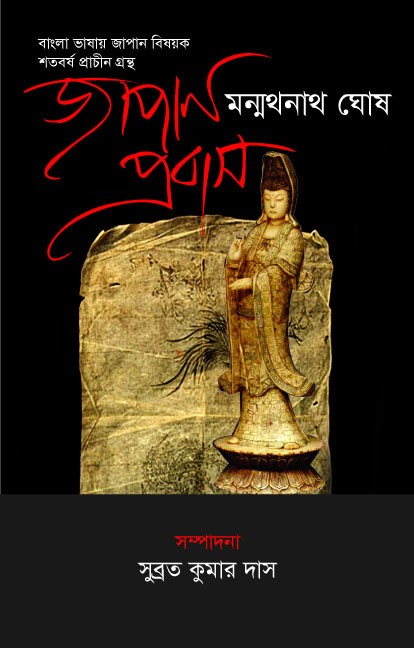
Every sunrise appears with the hope of the day illuminating not only the darkness but also wiping off the tears from paupers’ eyes. Japan, known as ‘Nippon’ or ‘Nihon’, the most prosperous country in Asia, is called ‘The land of the rising sun’. This compliment has really matched every instance of progress in Japan, even till now. This is reflected in every page of the book, ‘Japan Probash’, written by Manmatha Nath Ghosh more than a century ago. There are two startling themes of this book. It is the first book about Japan written in Bengali, on the one hand. On the other hand, the picturesque description of Japanese society given by the author in this book has not changed much even after such a long time span. This undiscovered resource of our literature has recently been revealed by Subrata Kumar Das, who has edited this book with great care by collecting almost all the information provided by Manmatha Nath Ghosh in his original book. Ghosh had to go to Japan in 1906 for purposes of education. He recorded aspects of Japanese life, culture and etiquette in detail as he experienced them in his three years’ stay in Japan. He did it in a critical manner but used very simple language and subsequently put them together in a book, in other words, the one under review from Kolkata in 1910. One hopes the Dhaka edition of the book, a century later, will be appreciated by readers.
During his stay in Japan he had to come in close contact with many Japanese families even as he pursued his studies. Consequently, he had a chance to understand the life, culture and psychology of the Japanese people. On the whole he has tried to give the flavour of the tough and hardworking lifestyle of the Japanese on one side of the coin and their ever beaming appearance on the other. They cannot break down even in the worst situation but remain calm and quiet. In this connection, one incident mentioned in the book by Ghosh will not be irrelevant to point out here. One day, while living in Tokyo, Ghosh was returning home from the house of one of his Japanese friends. On his way home he noticed that about 50 houses had been burnt down. And yet the author did not notice any distress in the expressions of the inhabitants of those houses. Instead of crying or screaming, the victims were found to be busy in extinguishing the fire.
The author had to travel different places in Japan, such as Tokyo, Kobe and Osaka in his academic interest. Though the experience that he gathered is noted in the book in a continuous flow within different sections, the whole book can be segregated in three different contents. To display the complete picture of the Japanese the author has revealed the facts of their personal, social and professional lives. The author has described all the parts in such a sensible manner that it cannot be felt monotonous as one reads the book. In a few parts, short Japanese conversations in Bengali make the journey through this book more interesting. While sketching the personal lives of the Japanese the author did not forget to mention their good manners even towards their maid servants. It is true that Japanese people do not waste time in unnecessary gossip, but they are not unsocial. Whatever the social program, marriage ceremony or funeral, they gather together. They do not mourn in an outburst of emotions at the death of their friends, relatives or even any member of the family in the same way that they express their feelings fully on any joyous event. In their philosophy, as death is common incident in life and a person must die once he is born, so exaggeration in mourning is thought to be unnecessary by the Japanese. They have been able to triumph over sorrow and distress by dint of their sportive character.
The author has highlighted the health consciousness of the Japanese by mentioning their diet and appetite. Green tea is one of the most popular drinks that they serve their guests on every occasion either at home or other places. In the period of time Ghosh is speaking of, the Japanese hated to add oil in their food, although nowadays they use oil in their food on quite a few occasions. However, they live on raw fish, vegetables or raw meat even now, besides partaking of burnt or fried fish, meat or vegetables.
We have always known that the Japanese are proactive, skillful and hardworking. The author has focused on these issues by mentioning different incidents or observations. It can be comprehended only by going through the description of socks manufacturing given by the author.
Two phases have been observed in the character of the Japanese. While living in the boarding in Osaka and with one of Japanese families named Uraiya, Ghosh got an opportunity to learn about the character of the Japanese. Though the author was impressed with the behavior and the integrity of the Japanese, he was nevertheless disappointed with Japanese character to some extent. For instance, he has mentioned their bathing system, which is called ‘onsen’ or hot spa. In this case, about 20 to 25 persons used to take a bath in one bathtub together by getting undressed. The author considered it offensive compared to the customs of the people of Indian subcontinent.
One of the most important characteristics of this book is the footnotes through which the author explains the particular meaning and usage of some Japanese words. In order to make the reading of this book more useful, Subrata Kumar Das has demonstrated his erudition through his compilation of the information given by Ghosh, which is followed by the incorporation of editorial comments published in different newspapers and magazines on this book in 1910 and 1911 at the end of the work.
